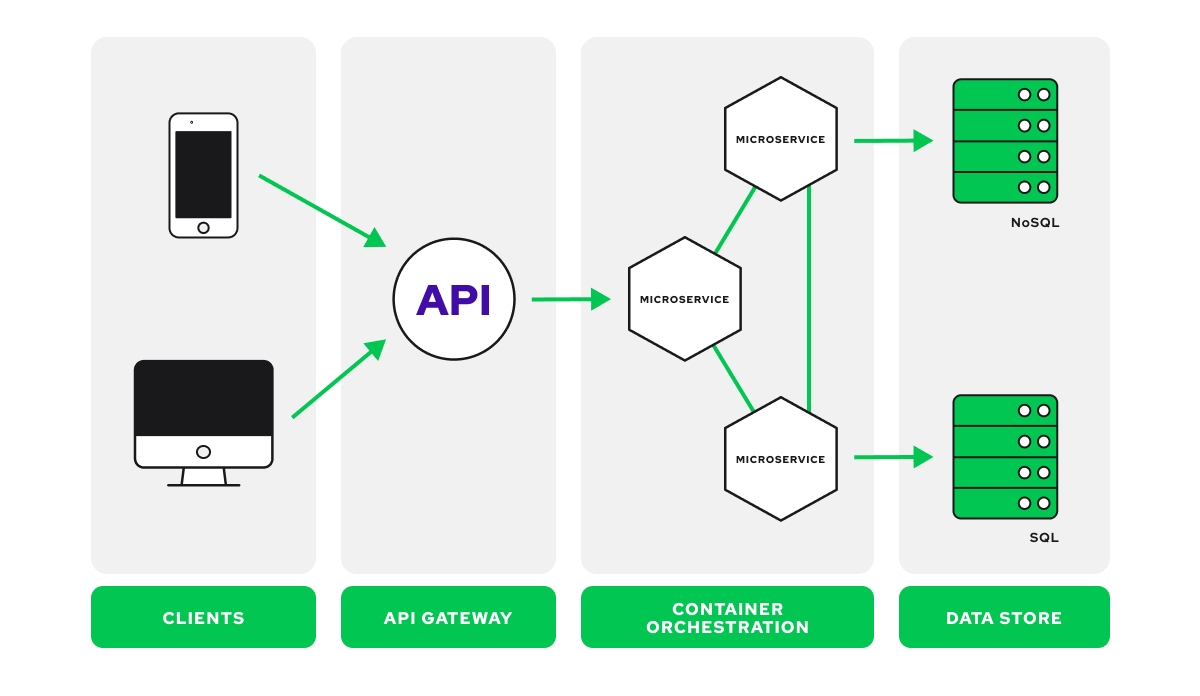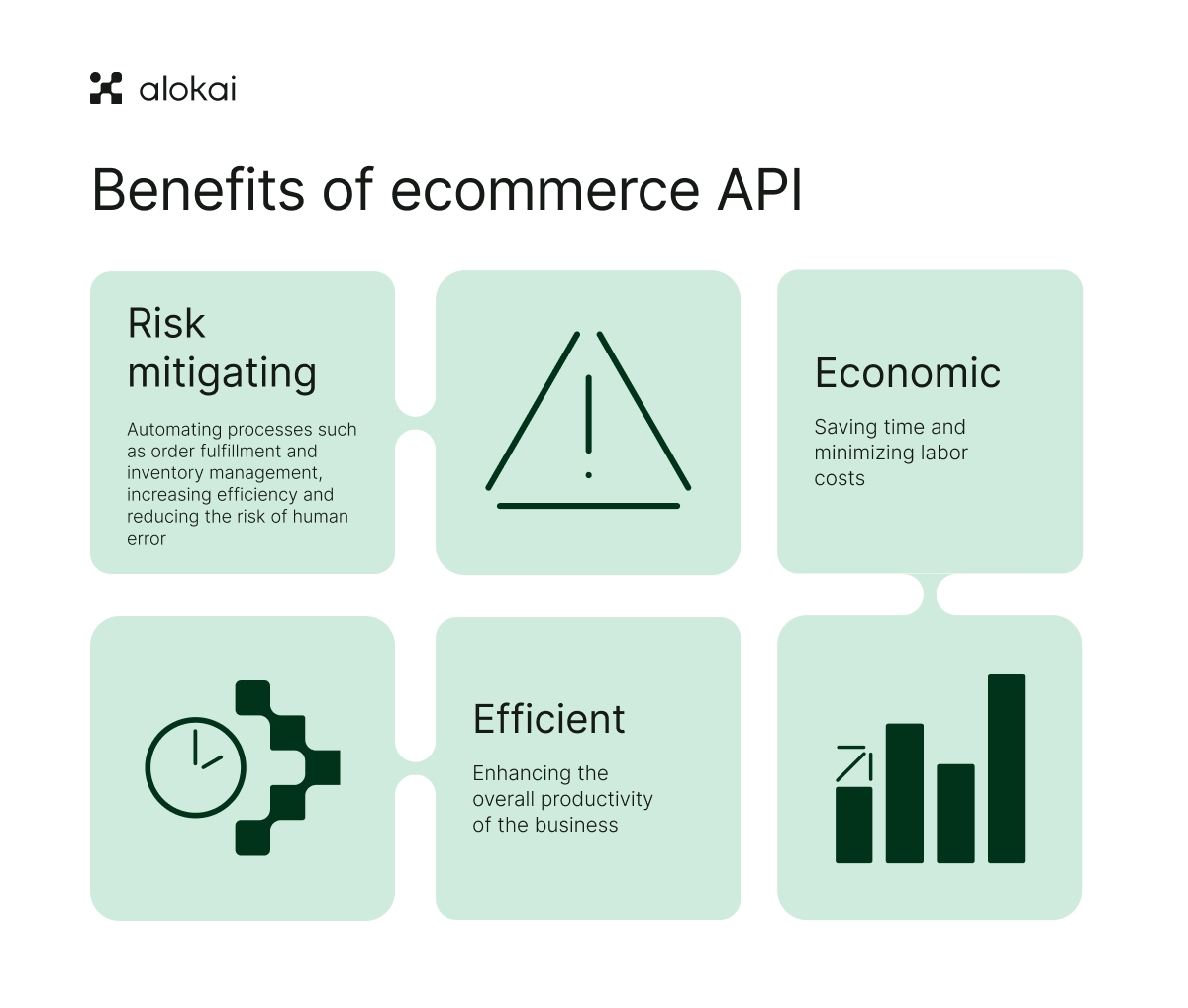Ecommerce APIs, including API ecommerce solutions, connect different software systems to enhance your online store’s functionality. They streamline communication between components like inventory and payment gateways. This guide will cover the essentials of ecommerce APIs, their benefits, types, and how API ecommerce can transform your business.
Key takeaways
- Ecommerce APIs are essential for streamlining operations, enabling the integration of various services such as inventory management, customer relations, and payment gateways, thereby enhancing the overall efficiency of online stores.
- Using different ecommerce APIs—such as catalog, checkout, cart, shipping, and login APIs—ensures a seamless and personalized shopping experience by automating processes, managing customer data securely, and synchronizing information across platforms.
- Implementing and maintaining ecommerce APIs involves a strategic approach, including clear goal-setting, selecting the right APIs, ensuring security, and using advanced analytics to gain insights into consumer behavior for improved marketing and customer service strategies.
Understanding ecommerce API

Stepping into the world of online retail, it’s essential to grasp the concept of the ecommerce API, a cornerstone of digital commerce that connects the dots across the virtual marketplace.
What is ecommerce API?
An API, or application programming interface, acts as a bridge between different software programs, allowing them to communicate effortlessly. It’s the glue that holds together the various components of an ecommerce business, from inventory management to customer relations, ensuring a smooth exchange of data and services.
Most ecommerce APIs work behind the scenes, their power in their ability to streamline the complex interplay of an ecommerce site’s operations. They enable developers to create a mosaic of interconnected applications that enhance the shopping experience without delving into the ecommerce platforms' intricate code. Think of an ecommerce API as a multilingual interpreter in the United Nations of ecommerce, translating and conveying messages across various systems and platforms.
The importance of ecommerce APIs cannot be overstated. They are the pillars supporting the growth and scalability of an ecommerce business. By leveraging these APIs, companies can:
- Customize their online presence
- Automate tedious processes
- Fortify their security measures
- Ensure their storefront remains cutting-edge and responsive to customer needs.
How ecommerce APIs work
.png?width=768&auto=webp&format=pjpg&disable=upscale&quality=100&dpr=2)
Imagine ecommerce APIs as the digital messengers of the internet, diligently relaying requests and delivering responses between software components. At their core, they utilize REST API architecture, a ubiquitous design that simplifies interactions using familiar HTTP protocols:
- GET to retrieve
- POST to create
- PUT to update
- DELETE to remove data
This architectural style ensures that ecommerce data is accessible and manipulable in a secure and efficient way.
The advent of composable commerce is a testament to the transformative power of ecommerce APIs. By decoupling the user interface from the backend services, these APIs empower businesses to select the best technologies for each aspect of their online presence, thereby crafting a flexible and resilient ecommerce stack. This approach caters to modern commerce's personalized needs and ensures that businesses are primed for future growth and innovation through effective ecommerce API design.
Furthermore, ecommerce APIs are not confined to a single format. They can also harness the capabilities of GraphQL, a query language that allows clients to request precisely the data they need, reducing overhead and improving performance. Through these sophisticated communication protocols, ecommerce APIs work tirelessly to integrate diverse services, from payment gateways to shipping providers, creating a seamless backend operation that supports the ever-evolving ecommerce industry.
Types of ecommerce APIs
Dive into the ecommerce ecosystem, and you’ll encounter a diverse array of specialized APIs, each serving a unique function within the online store’s infrastructure. One such example is the catalog API, which meticulously organizes product information, ensuring it’s up-to-date and synchronized across various systems. It is the backbone of any ecommerce website, enabling efficient management of an extensive product range.
Then there are the Checkout and Cart APIs, the cashiers of the digital market, processing transactions with precision and customizing the checkout experience to fit the ecommerce site’s unique brand. Meanwhile, Shipping APIs act as the logistics experts, automating the delivery process, calculating accurate shipping rates, and providing customers with real-time tracking information. The Sales Tax API also ensures proper tax calculations for a seamless transaction experience. These APIs collectively ensure that the journey is smooth and hassle-free from when a customer adds an item to their cart to when it arrives at their doorstep.
Not to be overlooked are the following ecommerce APIs:
- Login API: Manages customer identities and facilitates secure login and authentication.
- Subscription API: Facilitates recurring billing for subscription-based services.
- These APIs are essential for maintaining customer relationships, securing sensitive data, and ensuring a personalized and convenient shopping experience.
- Together, these ecommerce APIs form a cohesive system that streamlines operations and elevates the customer’s journey from browsing to buying.
Key benefits of using ecommerce APIs
Incorporating ecommerce APIs into your online business offers a treasure trove of benefits, including:
- Automating processes such as order fulfillment and inventory management, increasing efficiency and reducing the risk of human error
- Saving time and minimizing labor costs
- Enhancing the overall productivity of the business
These powerful tools can catapult your operations to new heights.

Consistency is king in ecommerce, and APIs are the loyal subjects ensuring the kingdom runs without a hitch. By facilitating real-time updates and maintaining data synchronization across various backend systems, APIs eliminate the chaos of data silos and enable a seamless flow of information. This harmonious data exchange ensures that every aspect of the ecommerce ecosystem, from logistics to customer support, operates in concert.
Moreover, the scalability offered by ecommerce APIs is a critical factor in the longevity of an online store. As businesses evolve and customer demands shift, APIs allow adding new features and expanding offerings without overhauling the existing system. The ability to scale effortlessly means that businesses can grow unencumbered, ready to adapt, and thrive in the dynamic landscape of ecommerce.
Enhancing customer experience with APIs
Pursuing an enhanced customer experience is a driving force in the ecommerce industry, and APIs are the catalysts for delivering personalized, engaging shopping encounters. By harnessing the power of customer data, APIs enable online stores to craft individualized product recommendations and create bespoke experiences that resonate with shoppers. This level of personalization captivates customers and encourages loyalty and repeat business.
In an age where instant gratification is the norm, AI-powered chatbots, integrated via APIs, offer immediate and personalized customer support, ensuring queries are addressed efficiently and effectively. These conversational agents, coupled with real-time updates on order confirmations and tracking, keep customers informed and satisfied, fostering a sense of trust and reliability.
Ecommerce APIs also play a pivotal role in understanding and catering to consumer behavior. By tracking user activity and leveraging advanced analytics, businesses can:
- Fine-tune their strategies to maximize both customer satisfaction and profit margins
- Gain insights from API-driven data monitoring
- Evolve continuously, staying ahead of the curve in delivering exceptional shopping experiences
Implementing ecommerce API integration
Implementing ecommerce API integration is a strategic process that requires careful planning and execution. It begins with identifying the goals and requirements of the ecommerce business, a crucial step that ensures the chosen APIs align with the company’s vision and objectives. Selecting the right APIs is a delicate balance of evaluating factors such as functionality, cost, and security, ensuring that the integration will bolster, rather than hinder, the business’s growth.
Once the appropriate APIs are chosen, obtaining credentials and diving into the API documentation are the next steps on the integration journey. This preparation lays the groundwork for developing the integration, which can be custom-coded for maximum flexibility or facilitated by integration tools for simplicity. Testing in a secure environment is essential, as it allows developers to iron out any kinks before going live, ensuring a smooth rollout that won’t disrupt the online store’s operations.
The work doesn’t stop post-deployment; ongoing maintenance is paramount to the longevity and effectiveness of API integrations. Regular updates, security checks, and performance monitoring are all part of the upkeep necessary to keep the ecommerce engine running smoothly. With tools like API2Cart, the complexity of managing these integrations can be simplified, providing a streamlined path to accessing multiple shopping platforms.
Security considerations for ecommerce APIs
In the digital marketplace, where sensitive customer data is exchanged with every click, security is not just a feature—it’s a necessity. Ecommerce APIs act as guardians of this data, employing encryption and secure protocols to shield it from nefarious actors. Implementing HTTPS protocols ensures that data in transit cannot be intercepted and access control measures keep unwanted visitors at bay.
To bolster security further, ecommerce APIs utilize multi-factor authentication and centralized OAuth servers, adding additional layers of protection and managing access with precision. API gateways stand watch, validating credentials and regulating traffic to prevent overloads and potential breaches. Regular security testing, including vulnerability scanning and penetration testing, is the proactive approach that ensures any weaknesses are discovered and addressed before they can be exploited.
These security measures are not merely a precaution; they’re an investment in the integrity of the ecommerce platform. With the rise of cyber threats, the importance of securing APIs has never been more pronounced, and the ecommerce industry is responding by prioritizing robust security at the API level. By safeguarding the digital storefront, businesses maintain their reputation and build trust with their customers.
Popular ecommerce platform APIs
Within ecommerce, certain platform APIs have risen to prominence, offering developers a wealth of functionalities to enhance online stores. Some of the popular platform APIs include:
- Shopify: Known for its comprehensive API offerings, including Admin APIs for backend management and Storefront APIs for fetching storefront-specific data.
- BigCommerce: Provides a suite of APIs that cater to various needs, from managing product catalogs to processing orders.
- Alokai: Offers a range of APIs for integrating with other headless commerce solutions.
These APIs provide developers the tools to create powerful and customized ecommerce websites.
These popular platforms understand the importance of staying current. Shopify releases new API.
Adopting and learning to use ecommerce APIs from these well-established ecommerce platform APIs allows for seamless integration and access to a range of features that can be customized to fit the unique branding and operational needs of an ecommerce business. By leveraging the power of these APIs, developers can create dynamic and responsive online stores that cater to the ever-changing demands of the digital consumer.
Leveraging APIs for advanced analytics
Beyond streamlining operations, ecommerce APIs are instrumental in unlocking the potential of advanced analytics. By automating data collection and analysis, APIs enable businesses to gain deep insights into consumer behavior, shedding light on purchasing patterns and preferences. This information is invaluable for optimizing marketing strategies, allowing companies to target their audience with precision and efficacy.
APIs help businesses refine their products and services by analyzing customer feedback from various channels, ensuring they meet and exceed customer expectations. By leveraging search and query tools, businesses can navigate vast amounts of sensitive customer data, extracting actionable insights that drive informed decision-making and implement effective business logic. Through this process, companies can enhance their customer relationship management strategies.
Integrating APIs with backend operations and data monitoring systems facilitates a level of understanding that transcends basic analytics. As ecommerce platforms harness these tools, they can deliver personalized experiences that resonate with customers, fostering loyalty and driving sales. In essence, leveraging APIs for advanced analytics is like having a crystal ball, offering a glimpse into the future needs and desires of the consumer market.
Common challenges in API ecommerce integration
While integrating ecommerce APIs can bring many benefits, the journey is not without challenges. The technological complexity of API integration poses a steep learning curve, requiring technical expertise and a willingness to stay abreast of the latest industry developments. Time is another critical factor, as establishing a single connection can take weeks, if not months, making the process both time-consuming and resource-intensive.
From an expenditure standpoint, the costs associated with professional development and maintenance can be substantial. Hiring skilled developers to build and manage API integrations is an investment not all businesses are prepared to make. Moreover, the necessity of ongoing maintenance and upgrades to ensure API functionality adds expense and complexity.
Yet, these challenges are not insurmountable. With proper planning, resource allocation, and the utilization of API management tools, businesses can navigate the rocky terrain of API integration. By understanding and addressing these common hurdles, companies can unlock the full potential of ecommerce APIs, harnessing their power to drive innovation and growth.
Future trends in API ecommerce
As we look toward the horizon of ecommerce, APIs are set to play a pivotal role in shaping its future. Headless and composable commerce are at the forefront of this movement, offering businesses unprecedented flexibility by decoupling the frontend from the backend processes. This separation allows for a more creative and agile approach to online retail, ensuring that ecommerce platforms can swiftly adapt to meet the evolving demands of the market.
Monetization of APIs is another emerging trend, with companies beginning to recognize the value of their internal and external APIs as revenue-generating assets. The rise of event-native API management and data streaming from internet-connected devices will redefine how businesses interact with their customers, providing real-time, data-driven experiences that cater to individual needs.
The future of ecommerce APIs is one of:
- Innovation and integration
- Leveraging best-of-breed technologies
- Creating personalized and seamless shopping experiences
- Remaining agile, customer-centric, and ahead of the curve in an ever-changing digital world
As the API landscape continues to evolve, it promises to unlock new possibilities for ecommerce platforms.
Summary
Ecommerce APIs are the powerhouse behind the scenes, driving innovation and enabling businesses to operate with efficiency, security, and scalability. From catalog management to advanced analytics, these APIs facilitate a seamless, intuitive shopping experience that keeps customers engaged and loyal. As we’ve explored the intricacies of ecommerce APIs, it’s clear that they are not just a technological asset but a strategic imperative for any online business looking to thrive in the digital marketplace. Embracing these tools and the trends that shape them will be essential for success in the ever-evolving world of ecommerce.













